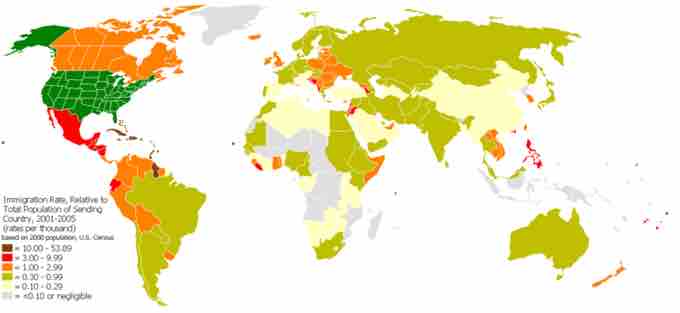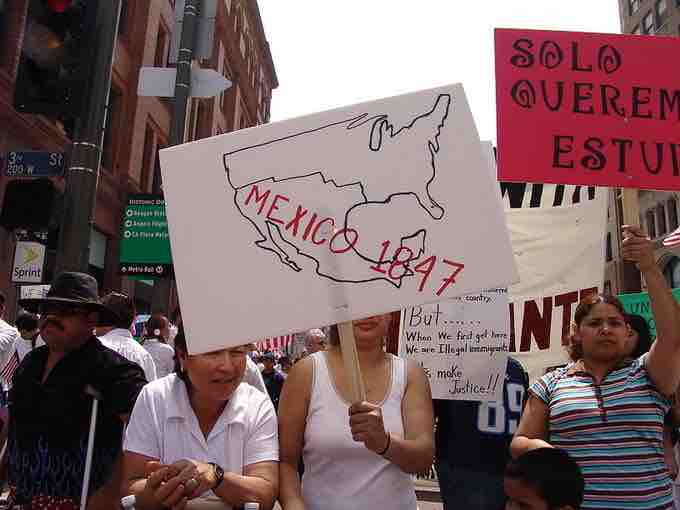Introduction
Immigration to the United States is a complex demographic phenomenon that has been a major source of population and cultural change throughout much of U.S. history . Immigration has political, social and economic impacts that have led to a variety of controversies regarding ethnicity, economic benefits, jobs for non-immigrants, settlement patterns, upward social mobility, crime, and voting behavior. These issues are exacerbated by the scale at which immigration occurs. In 2006, the United States accepted, as permanent residents, more legal immigrants than all other countries in the world combined. Illegal immigration also occurs, most notably across the Mexico-United States border, but this type of migration is difficult, expensive and dangerous for participants. Out of those who have immigrated to the U.S., the largest amount originated in Mexico, India, the Philippines, and China. Between 2000 and 2010, nearly fourteen million immigrants entered the United States.

2001-2005 Immigration Rate to the United States
Rate of immigration to the United States relative to sending countries' population size, 2001–2005
History
American immigration history can be viewed in four epochs: the colonial period, the mid-nineteenth century, the turn of the twentieth century, and post-1965.Each period denotes a time when particular national groups, races and ethnicities were migrating to the United States. Historians estimate that fewer than one million immigrants—perhaps as few as 400,000—crossed the Atlantic during the 17th and 18th centuries. The peak year of European immigration was in 1907, when 1,285,349 individuals entered the country. By 1910, 13.5 million immigrants were living in the United States.
The Immigration and Nationality Act of 1965 abolished an earlier immigration system that had set quotas on the number of people who could immigrate in a given year from particular countries. By equalizing immigration policies, the act resulted in new immigration from non-European nations, which changed the ethnic make-up of the United States. Immigration doubled between 1965 and 1970, and again between 1970 and 1990. In 1990, George H. W. Bush signed the Immigration Act of 1990. This further increased legal immigration to the United States by 40%.
Contemporary Immigration Patterns
Until the 1930s, most legal immigrants were male. By the 1990s, women accounted for just over half of all legal immigrants. Contemporary immigrants tend to be younger than the native population of the United States, with people between the ages of 15 and 34 substantially over-represented. Immigrants are also more likely to be married and less likely to be divorced than native-born Americans of the same age. In terms of regional patterns, immigrants are likely to move to, and reside in, areas populated by people with similar backgrounds . This phenomenon has held true throughout the history of immigration to the United States.

Chinatown (Manhattan, New York)
Chinatown, Manhattan, New York City 2009 on Pell Street, looking west towards Doyer and Mott.
Public attitudes about immigration in the U.S. were heavily influenced in the aftermath of the 9/11 attacks.According to a 2009 Gallup poll, after the attacks, only 52% of Americans believed that immigration was a good thing overall for the U.S., down from 62% the year before.
Contemporary immigrants settle predominantly in seven states: California New York, Florida, Texas, Pennsylvania, New Jersey and Illinois. These states are large and comprise about 44% of the U.S. population as a whole . As of 2000, the combined immigrant population residing in these seven states accounted for 70% of the total foreign-born population. If current birth rate and immigration rates were to remain unchanged for another 70 to 80 years, the U.S. population would double to nearly 600 million.

May Day Immigration Rally
Immigrant rights march for amnesty in downtown Los Angeles, California on May Day, 2006.